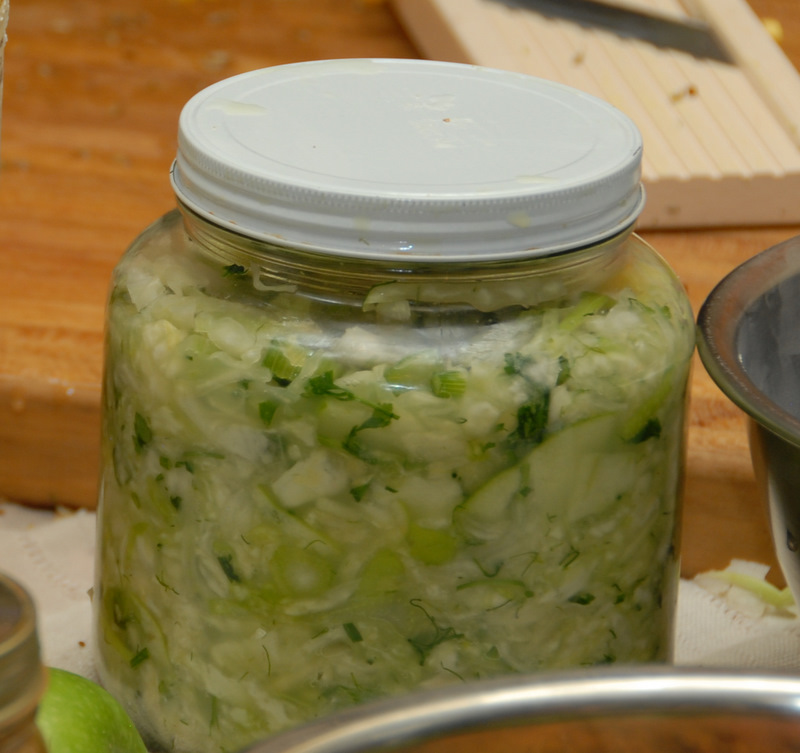Apple & Fennel Kraut
Recently, a group of folks met at Fresh Thymes Eatery (FTE) for a fall fermenting workshop led by our fearless fermento, Mara. FTE is the new Community Supported Restaurant in Boulder that features a variety of naturally fermented dishes and drinks. That’s what made it such an ideal location to hold an ozuké pickled things event. Christine Ruch, chef & owner, does a superb job of preparing real food with whole ingredients. Her menu is completely gluten free, seasonal, and locally-sourced when possible. In addition to being a great restaurant, Fresh Thymes is a community gathering spot. The friendly staff worked with the ozuké team to put together an instructive kraut making & tasting session.
 Once everyone arrived, Mara began teaching us how to channel our inner pickleteer. The group was pretty diverse with kids, teens, men & women attending. The kids were as busy as the adults taking notes on fermenting techniques. For more information on fermenting and some great recipes Mara suggests The Art of Fermentation and Wild Fermentation by Sandor Katz.
Once everyone arrived, Mara began teaching us how to channel our inner pickleteer. The group was pretty diverse with kids, teens, men & women attending. The kids were as busy as the adults taking notes on fermenting techniques. For more information on fermenting and some great recipes Mara suggests The Art of Fermentation and Wild Fermentation by Sandor Katz.
 It was nice to have young ones amongst us, as we hope they carry on the tradition of making naturally fermented pickled things for a long time. Plus, it’s fun just watching them enjoy delicious food, isn’t it?
It was nice to have young ones amongst us, as we hope they carry on the tradition of making naturally fermented pickled things for a long time. Plus, it’s fun just watching them enjoy delicious food, isn’t it?
In between snacking, we learned how to make a crunchy apple & fennel kraut. There was a lot of slicing, chopping, and pounding involved. Here’s Mara’s recipe:
 Ingredients for Fennel & Apple Kraut:
Ingredients for Fennel & Apple Kraut:
2 Cabbage heads, medium
2 Apples, tart & firm
1 Fennel bulb, small
1 Parsley bunch, chopped
Salt to taste
Directions:
Clean and wash all vegetables. Slice cabbage, fennel, & apples into narrow strips (alternatively use a processor or mandolin). Chop parsley. Combine all ingredients in large bowl. Salt to taste and mix thoroughly. Use a mallet or meat tenderizer to pound vegetables for approximately 15 minutes. Pounding vegetables releases their natural juices. Pack kraut into jars, being sure to have the vegetable juice cover kraut mixture completely. If temperatures are warm, store approximately 3 days on counter top. If temperatures are cooler, store for as long as a week or until desired taste is reached.
 This delicious fall kraut goes well with roasted chicken and pork. It is also excellent tossed with roasted winter squash in a salad. Try this recipe and let us know what how your home ferments go. We welcome your comments and questions always.
This delicious fall kraut goes well with roasted chicken and pork. It is also excellent tossed with roasted winter squash in a salad. Try this recipe and let us know what how your home ferments go. We welcome your comments and questions always.

I am wondering why the amount of salt is not given as a percent of the weight of the vegitables?
The purpose of the salt is to enhance flavor and pull out vegetable juices. Salt is not given as a percent of vegetable weight because any amount can be added, and tastes vary from person to person. Remember, a successful ferment occurs when all vegetables are completely covered in liquid or brine. The amount of salt will not impact the ferment.
I notice that in the list of ingredients for the recipe above there’s no added liquid. Is the only liquid from the veggies themselves? I.e. from “pounding” them? Thanks so much for any info on this and for sharing this recipe. I’m looking forward very much to trying it. Suzanne
Liquid is from pounding the veggies. We don’t want to dilute the enzymes and live content of the veggies. Salt also helps to draw liquid from the cabbage. Even if you can’t get a lot of liquid to appear on day one, weight your ferment and you will see that the salt will draw more liquid out by day two or three.
I just finished mixing this up and I can’t wait! Even raw, the texture and flavors are lovely. I had chopped a little too much for my kraut pot so we ate some right away in a salad with hazelnuts, blue cheese and dried cranberries. Yummy!!!